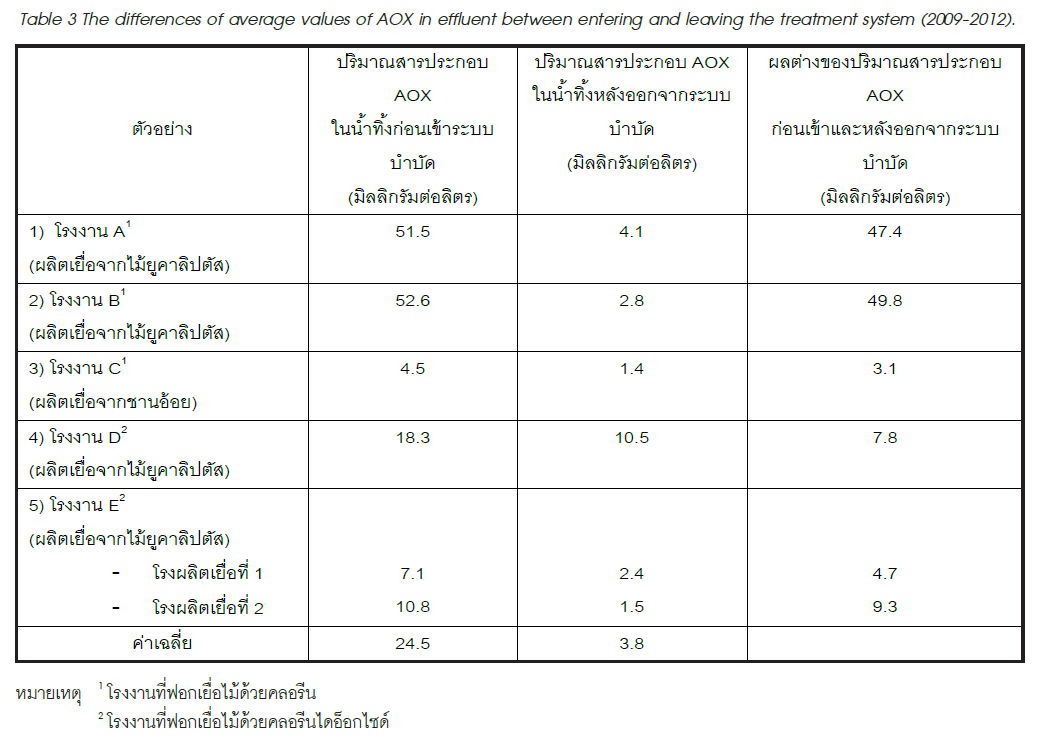A comparison of the amount of AOX in effluent before entering and after leaving wastewater treatment system in pulp and paper mills in Thailand
DOI:
https://doi.org/10.60136/bas.v2.2013.242Keywords:
Effluent, Adsorbable Organic Halogen, AOX, Pulp and paper millsAbstract
Pulp and paper industry is one of the leading industries that has a high impact on environment, especially effluent from the bleaching process using chlorine and its compounds. The byproducts from this bleaching process are AOXs (Adsorbable organic halogen) which are very toxic, persistency and bioaccumulation. Over 80 percent of pulp and paper mills in Thailand use chlorine and its compounds as main chemicals in bleaching process, therefore, the objective of this research was to analyse the amount of AOX produced from the bleaching process in effluent before entering and after leaving wastewater treatment system and then compare those results. Effluent samples were collected from all 5 pulp mills in Thailand every 3 month for 3 years (2009-2011). It was found that, where using chlorine dioxide as the main bleaching chemical, there was more amount of AOX in the effluent from the pulp mills using eucalyptus as raw material than in the effluent from the pulp mills using bagasse as raw material. For those pulp mills using eucalyptus as raw material, there was more amount of AOX in the effluent from pulp mills using chlorine as the main bleaching chemical than in the effluent from pulp mills using chlorine dioxide as the main bleaching chemical. Season and rainfall had no effect on the amount of AOX in the effluent samples. It was also found that the amount of AOX in effluent decreased after leaving wastewater treatment system. The Thai Green Label had used the data from this research to modify its standard for paper products in 2011.mg g-1 of dry ash. The absorption isotherms with pH from 7.0 to 8.0 and used 10 g of fly ash per 1 l of initial Hg concentration were the optimize condition. The leaching test of mercury bond fly ash is lower than legal concentration (less than 2 mg/l). The results indicated that fly ash from coal fired power plant can be used to stabilize low concentration of mercury in aquatic condition.
References
การฟอกเยื่อ เล่ม 1. (เอกสารเผยแพร่) บริษัท สยามคราฟท์ จำกัด.
ณรงค์ วุทธเสถียร. เทคโนโลยีการผลิตกระดาษ คุณสมบัติของกระดาษ ภาค 4 คุณสมบัติด้านทัศนศาสตร์. (เอกสารเผยแพร่) บริษัท แอ็ดวานซ์ อะโกร จำกัด (มหาชน).
โครงการฉลากเขียว. ข้อกำหนดฉลากเขียว ผลิตภัณฑ์กระดาษ (Paper). (เอกสารเผยแพร่) สำนักงาน เลขานุการโครงการฉลากเขียว สถาบันสิ่งแวดล้อมไทย สำนักงานมาตรฐานผลิตภัณฑ์อุตสาหกรรม. 2554.
International Organization for Standardization. Paper, board and pulps - Determination of total chlorine and organically bound chlorine. ISO 11480, 1997.
International Organization for Standardization. Water quality-Determination of adsorbable organically bound halogens (AOX). ISO 9562:2004, 2004.
Scandinavian pulp, paper and board testing committee. Water-extractable organically bound chlorine. SCAN-W 9: 89, 1989.

Downloads
Published
How to Cite
Issue
Section
License
Copyright (c) 2013 Bulletin of Applied Sciences

This work is licensed under a Creative Commons Attribution-NonCommercial-NoDerivatives 4.0 International License.









